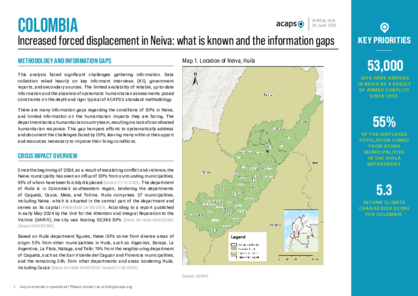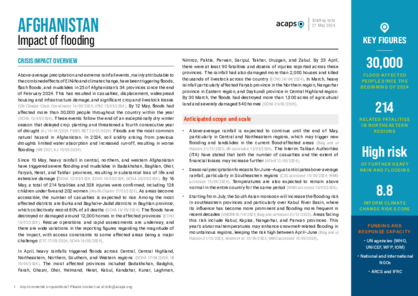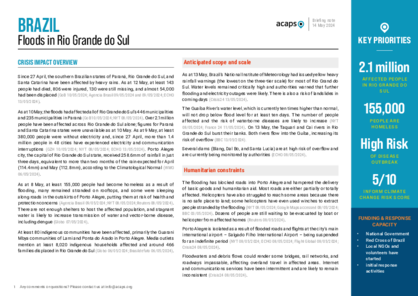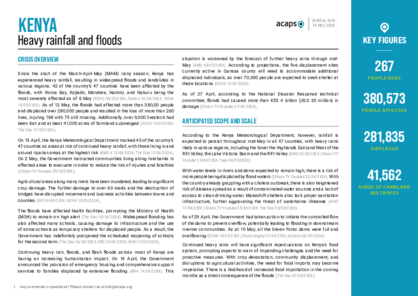HUMANITARIAN IMPACT OF EL NIÑO IN 2024
El Niño is expected to continue at least until April 2024.
El Niño-induced temperature and precipitation anomalies will continue during the first semester of 2024 in Central and South America (dry/wet conditions), East Africa (wet conditions), southern Africa (dry conditions), and Asia and the Pacific (dry/wet conditions).
Increasing humanitarian needs
Between January and June 2024, several countries already facing humanitarian crises may experience heatwaves, wildfires, floods, droughts, and epidemics due to El Niño.
El Niño is likely to increase humanitarian needs of the exposed populations, with food security and health expected to be the most affected sectors.
Climate change has the potential to amplify Niño-induced rainfall and temperature anomalies, triggering unpredictable and potentially more extreme outcomes.
JANUARY- JUNE 2024
RISK OF HUMANITARIAN IMPACTS FROM EL NIÑO
Disclaimer: Timor Leste and Vanuatu are not visible on this map. For more detailed information, please access the report.
What does ENSO stand for?
ENSO stands for El Niño and Southern Oscillation, a periodic fluctuation in sea surface temperature and changes in the air pressure across the equatorial Pacific Ocean.
ENSO is one of the main drivers of interannual climate variability. The two extreme ENSO phases are El Niño and La Niña. El Niño occurs when the surface waters in the central and eastern Pacific Ocean become warmer than average, and La Niña occurs when these waters become cooler than average. These changes in sea-surface temperatures can cause shifts in atmospheric pressure and winds, leading to changes in rainfall patterns, temperature, and other weather-related phenomena worldwide.
Climate change can amplify the rainfall variability related to ENSO and increase the likelihood of extreme weather events. Global warming is also increasing ENSO ‘variability’, and strong El Niño and La Niña events have occurred more frequently than the pre-1960 average. More frequent swings from a strong El Niño to a strong La Niña are anticipated in the future.
GLOBAL HUMANITARIAN IMPACTS OF EL NIÑO
Click on this interactive diagram to explore the rainfall and temperature anomalies, the associated hazards, and the main humanitarian impact dimensions of El Niño.
How does ACAPS assess the risk of El Niño impact?
The assigned risk level of El Niño impact is based on expert judgement following an assessment per country of the indicators/factors listed on the right:
Historical impact of previous El Niño events in the country
Typical influence of El Niño between January and June in the country
Seasonal precipitation and temperature forecast for the first semester of 2024
Impact of El Niño in 2023 in the country and materialisation of seasonal forecasts/alerts
Pre-existing humanitarian crises and vulnerabilities to El Niño-related hazards
Agricultural seasonality
National/local response capacity to natural hazards/impact from natural hazards
Expected impact on agriculture, livestock, and fishery
Potential spill-over effects of El Niño on local food prices and the economy
Potential disease outbreaks and increased health needs
Analysis products
on
Global climate analysis
24 June 2024
Colombia: increased forced displacement in Neiva - what is known and the information gaps
DOCUMENT / PDF / 932 KB
Since the beginning of 2024, as a result of escalating conflict and violence, the Neiva municipality has seen an influx of IDPs from surrounding municipalities, 95% of whom have been forcibly displaced.
28 May 2024
Global increase of cholera: aggravated by vaccine shortage and El Niño
DOCUMENT / PDF / 341 KB
This report highlights the key contributing factors and aggravating conditions that can increase the global prevalence of cholera, focusing particularly on the impact of the global OCV shortage that is heightening humanitarian needs among affected populations and those vulnerable to spread.
21 May 2024
Afghanistan: impact of flooding
DOCUMENT / PDF / 1 MB
Above-average precipitation and extreme rainfall events, mainly attributable to the combined effects of El Niño and climate change, have been triggering floods, flash floods, and mudslides in 25 of Afghanistan’s 34 provinces since the end of February 2024.
14 May 2024
Brazil: floods in Rio Grande do Sul
DOCUMENT / PDF / 849 KB
Since 27 April, the southern Brazilian states of Paraná, Rio Grande do Sul, and Santa Catarina have been affected by heavy rains. As at 12 May, at least 143 people had died, 806 were injured, 130 were still missing, and almost 54,000 had been displaced.
14 May 2024
Kenya: heavy rainfall and floods
DOCUMENT / PDF / 2 MB
Since the start of the March-April-May (MAM) rainy season, Kenya has experienced heavy rainfall, resulting in widespread floods and landslides in various regions. 42 of the country’s 47 counties have been affected by the floods, with Homa Bay, Kajiado, Mandera, Nairobi, and Nakuru being the most severely affected as of 6 May.






